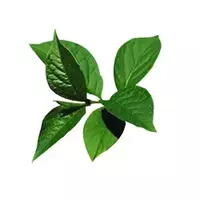Lime leaves

There is a common belief that lime is a type of lemon. Note that it is fundamentally wrong. Despite this, lime still belongs to the Citrus family. Some scientists have hypothesized that it was lemon that appeared as a result of crossing lime and some other fruits of the Citrus family. Visually, the fruit is similar in both shape and color. Lime appeared on the Malacca Peninsula, located in Southeast Asia. Much later, they migrated to the Mediterranean.
Since its inception, lime has been no less popular in our country than the lemons themselves. This can be said not only about the fruit, but also about some of its elements. These include lime leaves. They are used, as a rule, as a spice in a variety of dishes. This is especially characteristic of Thai cuisine.
They began to use leaves as their own seasoning for a long time. Very quickly, encouraging results were obtained: the dish gained a much more whole taste, giving a pleasant smell of essential oils with notes of citrus.
Lime Leaf Composition
It is the chemical composition that makes lime leaves such a popular seasoning. And this despite the fact that they have practically no nutritional value. For the most part, the leaves are composed of water, essential oils and some acids. They create a special aroma and contribute to the normalization of digestion.
Lime Leaf Use Options
Cooking mainly uses kaffir lime leaves. They are extremely popular in Southeast Asian countries. You can now meet them in our country. The leaves are used for cooking fish and chicken, in soups and curries, with beef and pork, etc. The completely citrus aroma of the leaves can only be felt if you tear them or finely cut them.
Lime leaves can also be found in the bartender environment. With their help, a lot of cocktails are prepared, distinguished not only by their excellent taste, but also by a pleasant smell. The most famous among them are the note in mi, the lucky ticket, the butterfly effect and the berry Versailles.
lime leaves kCal
Energy value of lime leaves (Ratio of proteins, fats, carbohydrates - ju):
Proteins: g (~ 0 kCal)
Fats: g (~ 0 kCal)
Carbohydrates: g (~ 0 kCal)
 Español
Español Français
Français Português
Português Русский
Русский 简体中文
简体中文 繁體中文
繁體中文 日本語
日本語 한국어
한국어 العربية
العربية Türkçe
Türkçe Қазақ
Қазақ Deutsch
Deutsch Italiano
Italiano Українська
Українська
